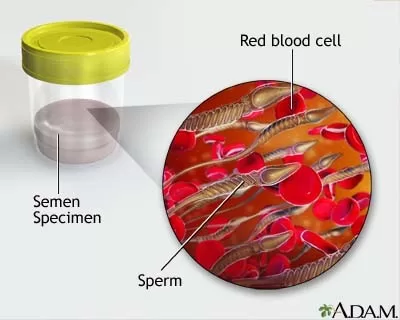Blood in semen, a condition medically referred to as hematospermia, is a topic that raises concern among many men. While it may not always indicate a severe medical issue, it is essential to understand the causes of blood in semen, recognize the symptoms of hematospermia, and know when to seek help. This comprehensive guide aims to shed light on the various factors contributing to this condition, including infections and trauma, while emphasizing the importance of prostate health. Addressing blood in semen with the right information can alleviate fear and encourage timely intervention when necessary. For anyone experiencing this alarming symptom, it is crucial to stay informed and proactive about their health.
The presence of blood in semen, often termed hematospermia, can be an unsettling experience for men. This phenomenon, which can arise from a variety of underlying health issues, necessitates a closer look at its potential causes and associated symptoms. Understanding factors such as infections, trauma, and even prostate-related conditions can provide clarity and direction for those affected. Additionally, knowing when to seek medical assistance for blood in semen is critical for maintaining overall reproductive health. By delving into this topic, we can better equip individuals with the knowledge to address their concerns and promote prostate health.
Understanding Hematospermia: What You Need to Know
Hematospermia, or blood in semen, can be a distressing experience for men of all ages. While many cases resolve spontaneously, understanding the underlying factors is essential for managing and addressing this condition. It is important to differentiate between benign causes, such as minor trauma or infections, and more serious conditions that may require medical attention, such as prostate issues or tumors. Knowing what hematospermia entails is the first step toward seeking appropriate care.
The presence of blood in semen can be alarming, but it is often the result of relatively harmless conditions. Many young men experience hematospermia due to non-threatening causes like infections or inflammation. However, it is paramount for individuals to monitor their symptoms and recognize when to seek help, particularly if there are accompanying signs of illness.
Common Causes of Blood in Semen
Infections and inflammation are among the most common causes of hematospermia. Conditions such as prostatitis and seminal vesiculitis can lead to blood in the semen. Prostatitis, an inflammation of the prostate gland, often presents with pelvic pain and discomfort, while seminal vesiculitis affects the seminal vesicles and can similarly result in hematospermia. These infections may require antibiotics or other treatments to alleviate symptoms and resolve the underlying issue.
Trauma is another potential cause of blood in semen, which can occur due to vigorous physical activity or injuries sustained during sexual intercourse. Surgical procedures, especially biopsies or vasectomies, may also lead to short-term hematospermia as a side effect of tissue healing. Understanding these causes can help individuals manage their symptoms effectively and know when to consult their healthcare provider.
Recognizing Symptoms Associated with Hematospermia
While blood in semen can occur without additional symptoms, certain signs can indicate a more serious underlying condition. Painful ejaculation, pelvic pain, or persistent bleeding may signal an infection or inflammation that necessitates further investigation. It is crucial for individuals experiencing these symptoms to consult a healthcare professional to rule out potential complications.
If hematospermia persists for more than a week or is accompanied by symptoms such as fever, weight loss, or changes in urination patterns, it is essential to seek medical attention. These symptoms could indicate a more serious condition, including sexually transmitted infections or even prostate cancer, particularly in older men. Early detection and intervention are key to managing health effectively.
When to Seek Professional Help for Blood in Semen
Determining when to seek help for blood in semen is vital for your health. While many cases of hematospermia resolve without treatment, persistent or recurrent symptoms, especially in men over 40, should prompt a visit to a healthcare provider. This is particularly important if the blood in semen is accompanied by significant discomfort or other alarming symptoms.
Consulting a healthcare professional allows for a thorough evaluation, including testing for infections or imaging studies to assess the prostate and surrounding structures. This proactive approach not only provides peace of mind but also ensures that any serious conditions, such as prostate cancer, are identified early and managed appropriately.
Prostate Health and Its Connection to Hematospermia
Prostate health is integral to understanding the presence of blood in semen. Conditions like prostatitis or prostate cancer can manifest as hematospermia, particularly in older men. Regular check-ups and screenings are essential for maintaining prostate health, especially as men age and the risk for prostate-related issues increases.
Men experiencing blood in semen should consider discussing their prostate health with their healthcare provider. Early detection of potential problems can lead to more effective treatment options and better health outcomes. Awareness of symptoms and risk factors associated with prostate conditions can empower individuals to take charge of their health.
Frequently Asked Questions
What is hematospermia and what causes blood in semen?
Hematospermia, or blood in semen, can arise from various causes, including infections like prostatitis and seminal vesiculitis, trauma to the reproductive organs, blood vessel malformations, or even tumors in the reproductive system. Understanding these causes is essential for proper diagnosis and treatment.
What are the common symptoms of hematospermia?
Symptoms associated with blood in semen may include painful ejaculation, pelvic pain, and other signs like fever or weight loss. If hematospermia persists for more than a week or is accompanied by concerning symptoms, it’s important to seek medical attention.
When should I seek help for blood in semen?
You should seek help for blood in semen if the condition lasts more than a week, if you experience pain during ejaculation, or if you have additional symptoms like fever, weight loss, or changes in urination. Early consultation can prevent serious underlying conditions.
Can prostate health affect the presence of blood in semen?
Yes, prostate health is closely linked to hematospermia. Conditions like prostatitis or prostate cancer can lead to blood in semen. Regular check-ups and awareness of prostate health are crucial, especially for men over 40.
Is blood in semen always a sign of a serious health issue?
Not necessarily. While blood in semen, or hematospermia, can be alarming, it is often benign, especially in younger men. However, persistent cases, particularly in older adults, should be evaluated by a healthcare professional to rule out serious conditions.
| Aspect | Details |
|---|---|
| Overview | Hematoma spermia, or blood in semen, is generally not life-threatening and can often resolve without treatment. |
| Common Causes | 1. Infection (e.g., prostatitis, seminal vesiculitis) 2. Trauma (injuries or surgical procedures) 3. Blood vessel malformations 4. Other factors (tumors, medications) |
| Symptoms | Painful ejaculation, pelvic pain, persistent blood in semen for over a week, fever, weight loss, frequent urination. |
| Associated Conditions | Potential links to STDs if accompanied by unusual discharge, fever, or genital sores. |
| ICD-10 Code | R36.1 |
| Professional Guidance | Consult a healthcare professional for persistent or recurrent symptoms, especially for men over 40. |
Summary
Blood in semen, or hematospermia, is a condition that can cause significant concern for many men. While it is often benign and may resolve on its own, understanding the potential causes, recognizing accompanying symptoms, and knowing when to seek medical advice is essential. Common causes include infections, trauma, and anatomical anomalies, while symptoms such as painful ejaculation or persistent blood should not be overlooked. In cases where blood in semen appears alongside other alarming signs, a healthcare professional’s evaluation is crucial to rule out serious underlying conditions. Being informed about this condition can lead to timely interventions and better health outcomes.
The content provided on this blog (e.g., symptom descriptions, health tips, or general advice) is for informational purposes only and is not a substitute for professional medical advice, diagnosis, or treatment. Always seek the guidance of your physician or other qualified healthcare provider with any questions you may have regarding a medical condition. Never disregard professional medical advice or delay seeking it because of something you have read on this website. If you believe you may have a medical emergency, call your doctor or emergency services immediately. Reliance on any information provided by this blog is solely at your own risk.








